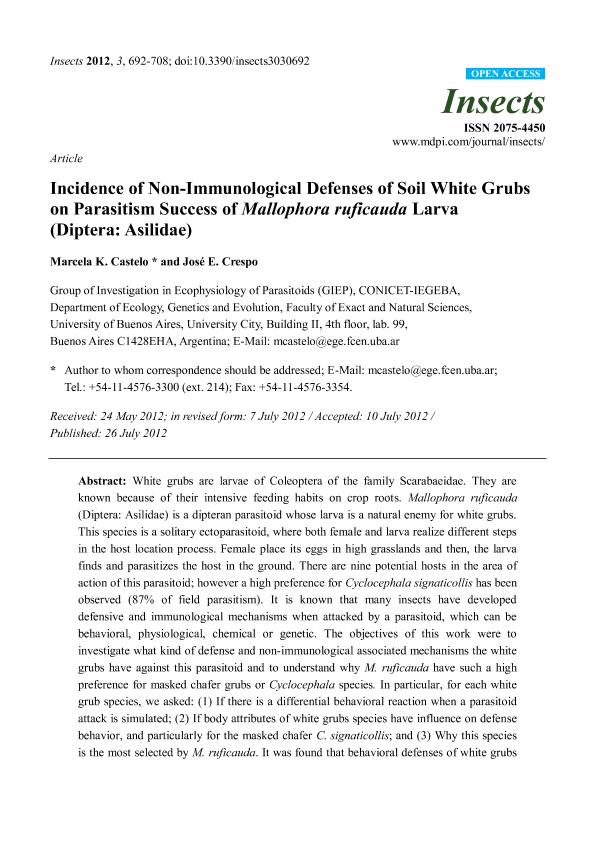Mostrar el registro sencillo del ítem
dc.contributor.author
Castelo, Marcela Karina

dc.contributor.author
Crespo, José Emilio

dc.date.available
2023-05-30T14:26:49Z
dc.date.issued
2012-07
dc.identifier.citation
Castelo, Marcela Karina; Crespo, José Emilio; Incidence of non-immunological defenses of soil white grubs on parasitism success of mallophora ruficauda larva (Diptera: Asilidae); MDPI AG; Insects; 3; 3; 7-2012; 692-708
dc.identifier.issn
2075-4450
dc.identifier.uri
http://hdl.handle.net/11336/198947
dc.description.abstract
White grubs are larvae of Coleoptera of the family Scarabaeidae. They are known because of their intensive feeding habits on crop roots. Mallophora ruficauda (Diptera: Asilidae) is a dipteran parasitoid whose larva is a natural enemy for white grubs. This species is a solitary ectoparasitoid, where both female and larva realize different steps in the host location process. Female place its eggs in high grasslands and then, the larva finds and parasitizes the host in the ground. There are nine potential hosts in the area of action of this parasitoid; however a high preference for Cyclocephala signaticollis has been observed (87% of field parasitism). It is known that many insects have developed defensive and immunological mechanisms when attacked by a parasitoid, which can be behavioral, physiological, chemical or genetic. The objectives of this work were toinvestigate what kind of defense and non-immunological associated mechanisms the white grubs have against this parasitoid and to understand why M. ruficauda have such a high preference for masked chafer grubs or Cyclocephala species. In particular, for each white grub species, we asked: (1) If there is a differential behavioral reaction when a parasitoid attack is simulated; (2) If body attributes of white grubs species have influence on defense behavior, and particularly for the masked chafer C. signaticollis; and (3) Why this species is the most selected by M. ruficauda. It was found that behavioral defenses of white grubs would explain the parasitism pattern of M. ruficauda larvae and its preference for C. signaticollis.
dc.format
application/pdf
dc.language.iso
eng
dc.publisher
MDPI AG
dc.rights
info:eu-repo/semantics/openAccess
dc.rights.uri
https://creativecommons.org/licenses/by/2.5/ar/
dc.subject
HOST VULNERABILITY
dc.subject
PARASITOIDS
dc.subject
SCARABAEIDAE
dc.subject.classification
Zoología, Ornitología, Entomología, Etología

dc.subject.classification
Ciencias Biológicas

dc.subject.classification
CIENCIAS NATURALES Y EXACTAS

dc.title
Incidence of non-immunological defenses of soil white grubs on parasitism success of mallophora ruficauda larva (Diptera: Asilidae)
dc.type
info:eu-repo/semantics/article
dc.type
info:ar-repo/semantics/artículo
dc.type
info:eu-repo/semantics/publishedVersion
dc.date.updated
2023-05-08T13:24:19Z
dc.journal.volume
3
dc.journal.number
3
dc.journal.pagination
692-708
dc.journal.pais
Suiza

dc.journal.ciudad
Basel
dc.description.fil
Fil: Castelo, Marcela Karina. Consejo Nacional de Investigaciones Científicas y Técnicas. Oficina de Coordinación Administrativa Ciudad Universitaria. Instituto de Ecología, Genética y Evolución de Buenos Aires. Universidad de Buenos Aires. Facultad de Ciencias Exactas y Naturales. Instituto de Ecología, Genética y Evolución de Buenos Aires; Argentina
dc.description.fil
Fil: Crespo, José Emilio. Consejo Nacional de Investigaciones Científicas y Técnicas. Oficina de Coordinación Administrativa Ciudad Universitaria. Instituto de Ecología, Genética y Evolución de Buenos Aires. Universidad de Buenos Aires. Facultad de Ciencias Exactas y Naturales. Instituto de Ecología, Genética y Evolución de Buenos Aires; Argentina
dc.journal.title
Insects
dc.relation.alternativeid
info:eu-repo/semantics/altIdentifier/url/https://www.mdpi.com/2075-4450/3/3/692
dc.relation.alternativeid
info:eu-repo/semantics/altIdentifier/doi/http://dx.doi.org/10.3390/insects3030692
Archivos asociados
